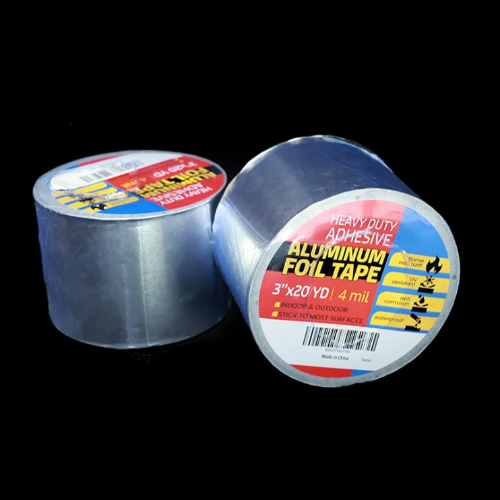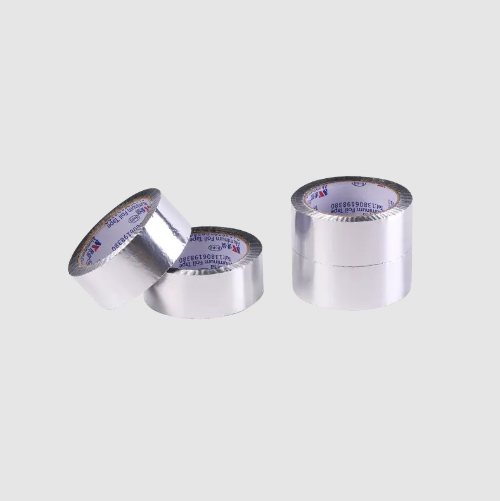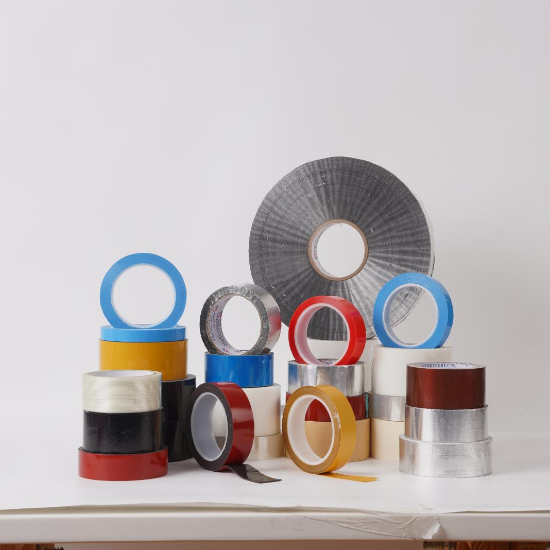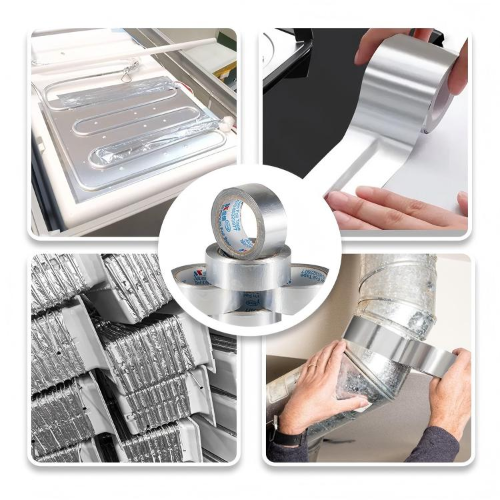In the realm of adhesive materials, few innovations have garnered as much attention in recent years as composited aluminum foil tape without liner. From hobbyists seeking polished metal effects to industrial engineers optimizing manufacturing processes, this material has emerged as a versatile solution with the potential to redefine standards across multiple sectors. But what exactly makes it stand out? How does its design address longstanding challenges in tape application? And why is it increasingly becoming the preferred choice for achieving both aesthetic and functional goals? This article explores the science, applications, and transformative potential of composited aluminum foil tape without liner, delving into its unique properties, real-world uses, and future possibilities.

Aluminum foil tape has been a staple in industries ranging from construction to electronics for decades. Traditional versions rely on a paper or plastic liner—a thin layer that separates the adhesive side of the tape from itself when rolled. While effective, this design comes with inherent limitations: the liner adds production costs, creates waste, and slows down application, as users must peel and discard it before use. For large-scale projects, this extra step can translate to hours of lost time and increased labor expenses.

Composited aluminum foil tape without liner represents a significant leap forward in solving these issues. By eliminating the liner entirely, manufacturers have created a tape that is self-winding, easy to apply, and more environmentally friendly. But the innovation goes beyond mere convenience. The “composited” aspect refers to its layered construction, which combines aluminum foil with other materials to enhance durability, flexibility, and performance. This hybrid design allows it to outperform traditional tape in everything from temperature resistance to adhesion strength, making it suitable for a far broader range of applications.
To appreciate the impact of this evolution, consider the history of adhesive technology. Early aluminum tapes were single-layer, prone to tearing, and limited in their ability to adhere to uneven surfaces. As demand grew for more robust solutions, manufacturers began laminating aluminum foil to plastic films (like PET or BOPP) to add strength. The next breakthrough came with the development of advanced adhesives—acrylic, rubber, and silicone-based formulas—that could withstand extreme conditions. Composited aluminum foil tape without liner builds on these advancements by integrating a release coating (typically silicone-based) on the non-adhesive side, allowing the tape to roll smoothly without sticking to itself. This eliminates the need for a liner, streamlining both production and use.

To understand why composited aluminum foil tape without liner is so effective, it’s essential to examine its structure at a microscopic level. Unlike traditional tape, which is often a simple sandwich of aluminum foil and adhesive, this composite material features multiple layers, each serving a specific purpose:
· Aluminum Foil Layer: The core component, typically 0.01mm to 0.05mm thick, provides conductivity, reflectivity, and barrier properties. It is often annealed (heat-treated) to improve flexibility, allowing the tape to conform to curved or irregular surfaces without cracking.
· Carrier Film: A thin layer of polyester (PET) or biaxially oriented polypropylene (BOPP) laminated to the aluminum foil. This adds tensile strength, preventing tearing and enhancing durability. PET is preferred for high-temperature applications, while BOPP offers better moisture resistance.
· Adhesive Layer: Applied to the aluminum side, this is the “working” part of the tape. The type of adhesive varies by use case: acrylic adhesives excel in UV and temperature resistance; rubber adhesives provide strong initial tack for quick fixes; silicone adhesives withstand extreme heat (up to 260°C).
· Release Coating: A thin layer of silicone oil on the carrier film side. This allows the tape to wind tightly without self-adhesion, replacing the need for a liner. The coating must be precisely calibrated—too little, and the tape sticks to itself; too much, and it may transfer to surfaces, weakening adhesion.
This layered structure is engineered to work in harmony. For example, the aluminum foil’s reflectivity (which can reach 85-95% for light and heat) combined with the carrier film’s insulation properties makes the tape ideal for thermal management. In HVAC systems, this means reducing heat loss by reflecting radiant energy back into ducts. In electronics, it shields components from electromagnetic interference (EMI) by blocking radio frequencies—a critical feature for sensitive devices like medical equipment or aerospace technology.
The adhesive layer’s chemistry is equally important. Acrylic adhesives, for instance, cross-link over time, forming stronger bonds when exposed to heat or moisture. This makes them suitable for outdoor applications, where they can withstand rain, snow, and UV radiation without degrading. Rubber adhesives, by contrast, are pressure-sensitive and form an immediate bond, making them perfect for quick repairs or temporary fixes. Silicone adhesives, with their high-temperature tolerance, are indispensable in automotive underhood applications or industrial ovens, where temperatures can exceed 200°C.

The shift toward composited aluminum foil tape without liner is driven by its ability to address the shortcomings of traditional tape. Here’s a closer look at its most significant benefits:
The absence of a liner eliminates a step in both production and application. For manufacturers, this reduces material costs (no need to source or apply liner materials) and simplifies the manufacturing process. For end-users, especially in industrial settings, this translates to faster application. A study by the Adhesive and Sealant Council found that linerless tape can reduce application time by up to 30% in large-scale projects, such as duct sealing in commercial buildings. This not only cuts labor costs but also accelerates project timelines, a critical factor in industries where delays incur penalties.
Liner waste has long been a concern in the adhesive industry. Traditional tape liners are often non-recyclable (especially those with silicone coatings) and end up in landfills. Composited aluminum foil tape without liner eliminates this waste stream entirely. Additionally, many manufacturers use recycled aluminum in the foil layer and water-based adhesives, further reducing their environmental footprint. For companies aiming to meet sustainability goals or comply with regulations like the EU’s Circular Economy Action Plan, this makes linerless tape a compelling choice.
The composite structure gives the tape superior performance in challenging conditions. Unlike single-layer aluminum tape, which can tear when stretched, the carrier film reinforcement allows composited aluminum foil tape without liner to withstand mechanical stress. This makes it suitable for applications like automotive wire harnessing, where vibration and movement could otherwise damage the tape. Its resistance to chemicals (including oils, solvents, and acids) also expands its use in industrial settings, such as chemical processing plants, where traditional tape would degrade quickly.
One of the most notable advantages is its ability to bond to a wide range of materials, including metal, plastic, glass, and even dusty or slightly rough surfaces. This is due to the adhesive’s “tack”—its ability to wet out (conform to) surface irregularities. In testing, acrylic-based linerless composite tape achieved 90% of its maximum bond strength within 24 hours, compared to 60% for traditional tape, which often requires the liner to be removed carefully to avoid contaminating the adhesive.
Composited aluminum foil tape without liner’s versatility is perhaps its most defining feature. It seamlessly transitions from aesthetic applications, where its polished finish is prized, to industrial roles, where durability and performance are critical.

For artists, designers, and hobbyists, the tape’s high reflectivity is a game-changer. Unlike paint or plating, which can be costly and time-consuming, composited aluminum foil tape without liner offers an instant, uniform metallic finish. Its thin, flexible nature allows it to wrap around intricate shapes—think sculptures, model trains, or furniture accents—without wrinkling. In interior design, it’s used to create accent walls with a “brushed aluminum” look or to add reflective details to lighting fixtures, enhancing brightness by bouncing light back into a room.
The key to its aesthetic appeal lies in the aluminum foil’s surface treatment. Manufacturers often polish the foil to a mirror-like finish before laminating it to the carrier film, ensuring that the tape retains its shine even after application. Unlike spray-painted metallic finishes, which can chip or fade, the tape’s aluminum layer is resistant to wear, making it suitable for high-traffic areas like retail displays or museum exhibits.
In the construction industry, composited aluminum foil tape without liner is revolutionizing ductwork installation. Its airtight seal prevents leaks, which can reduce HVAC efficiency by up to 30% according to the U.S. Department of Energy. The tape’s reflectivity also plays a role: by lining ducts with it, heat loss is minimized, as radiant energy is reflected back into the air stream. This is particularly valuable in cold climates, where maintaining duct temperature is critical for energy efficiency.
Contractors also appreciate its ease of use. In tight spaces, where peeling a liner would be cumbersome, linerless tape can be applied quickly with one hand, reducing fatigue and improving precision. Its ability to adhere to both metal ducts and insulation materials (like fiberglass) makes it a one-size-fits-all solution, eliminating the need for multiple tape types on a single job.
Electromagnetic interference (EMI) can disrupt the performance of sensitive electronics, from medical monitors to aerospace navigation systems. Composited aluminum foil tape without liner acts as a barrier, blocking radio frequencies (RF) and electromagnetic fields (EMF) due to aluminum’s conductivity. Its thin profile allows it to be wrapped around wires, circuit boards, or entire enclosures without adding bulk—an essential feature in miniaturized devices like smartphones or wearable tech.
In manufacturing, the tape is used to seal gaps in EMI shields, ensuring no stray signals leak in or out. Its adhesive bond is strong enough to withstand the vibrations of industrial machinery, making it reliable in factory settings where equipment can generate significant EMI.
The automotive industry relies on composited aluminum foil tape without liner for everything from heat shielding to wire bundling. Under the hood, silicone-adhesive versions protect wiring from the high temperatures of engines and exhaust systems. In electric vehicles (EVs), where battery thermal management is critical, the tape’s reflectivity helps dissipate heat, preventing overheating.
Its durability also makes it ideal for exterior applications, such as sealing seams on truck trailers to prevent water intrusion. Unlike traditional tape, which can degrade from road salt or UV exposure, linerless composite tape maintains its bond, reducing maintenance costs for fleet operators.
To illustrate the tape’s transformative potential, let’s examine two diverse case studies that highlight its versatility.
A team of artists in Berlin was commissioned to create a large-scale outdoor installation for a public square. The design called for 500 square meters of reflective surfaces to mimic the look of polished steel, but budget constraints ruled out using actual metal. Instead, they turned to composited aluminum foil tape without liner.
The tape’s flexibility allowed it to conform to the installation’s curved panels, while its high reflectivity created the desired mirror effect. Applying it was significantly faster than painting—two artists completed the job in three days, compared to the estimated two weeks for spray-on metallic coatings. Six months later, the installation remained intact, withstanding rain, wind, and UV exposure without fading or peeling. The artists noted that the tape’s durability exceeded their expectations, and its cost (approximately 10% of the price of steel panels) allowed them to stay within budget.
A major hospital in Toronto was undergoing a renovation of its HVAC system, with the goal of reducing energy consumption and improving air quality. The contractors chose composited aluminum foil tape without liner for sealing ductwork, citing its airtight bond and ease of use.
In testing, the tape reduced air leakage by 40% compared to the traditional liner tape used in other parts of the hospital. This translated to an estimated annual energy savings of $25,000. Additionally, the faster application time (30% quicker than liner tape) allowed the renovation to be completed during overnight shifts, minimizing disruption to patient care. Facility managers also noted that the tape’s resistance to mold (due to its non-porous surface) helped maintain indoor air quality—a critical factor in healthcare settings.
Not all composited aluminum foil tape without liner is created equal. Selecting the right product depends on the specific application, and understanding key variables is essential to achieving optimal results.
· Acrylic: Best for long-term outdoor use, UV resistance, and temperature ranges from -40°C to 150°C. Ideal for roofing, exterior ductwork, and solar panel installations.
· Rubber: Offers strong initial tack and adhesion to irregular surfaces. Suitable for temporary repairs, packaging, and indoor applications where temperature extremes are not a concern (range: -10°C to 80°C).
· Silicone: Withstands the highest temperatures (up to 260°C) and resists oils and solvents. Perfect for automotive underhood use, industrial ovens, and high-heat machinery.
The aluminum foil thickness (0.01mm to 0.05mm) affects both flexibility and durability. Thicker foil (0.03mm+) is better for heavy-duty applications like industrial sealing, while thinner foil (0.01mm-0.02mm) is more flexible for wrapping intricate shapes. Width options range from 10mm to 1000mm; narrower widths are suited for detail work (like electronics), while wider rolls are efficient for large surfaces (like ductwork).
For applications requiring maximum shine (e.g., art, decorative finishes), look for tape with a polished aluminum surface (reflectivity ≥90%). For EMI shielding or thermal conductivity, prioritize high-purity aluminum (≥99.5%), as impurities can reduce conductivity.
Check for certifications like UL (Underwriters Laboratories) for flame resistance, or RoHS compliance for electronics applications (restricting hazardous substances). For outdoor use, ensure the tape is rated for UV resistance to prevent degradation.
|
Feature |
Composited Aluminum Foil Tape Without Liner |
Traditional Aluminum Foil Tape |
|
Application Time |
30% faster (no liner to peel) |
Slower (requires liner removal) |
|
Waste Production |
None (linerless design) |
Significant (liner disposal) |
|
Durability |
High (carrier film reinforcement) |
Moderate (prone to tearing in single-layer designs) |
|
Temperature Range |
-40°C to 260°C (depending on adhesive) |
-20°C to 120°C (limited by adhesive and foil strength) |
|
Adhesion to Rough Surfaces |
Excellent (adhesive wets out irregularities) |
Poor (liner removal can contaminate adhesive) |
|
Cost (Long-Term) |
Lower (faster application + less waste) |
Higher (labor costs + liner materials) |
|
Environmental Impact |
Reduced (recyclable materials, no liner waste) |
Higher (non-recyclable liners, more material use) |
|
Industry |
Primary Use Case |
Key Benefit |
Recommended Adhesive Type |
|
Art & Design |
Creating shiny metal finishes on sculptures, decor |
Instant, uniform reflectivity; easy to shape |
Acrylic (UV resistance) |
|
Construction |
Sealing HVAC ducts, thermal insulation |
Airtight seal; reduces energy loss |
Acrylic |
|
Electronics |
EMI shielding for circuit boards, wire harnessing |
Blocks RF/EMF; thin profile for miniaturized devices |
Acrylic or silicone |
|
Automotive |
Heat shielding, underhood wire protection |
Withstands high temperatures and vibration |
Silicone |
|
Aerospace |
Thermal management in aircraft cabins, engine parts |
Extreme temperature resistance (-50°C to 200°C) |
Silicone |
|
Manufacturing |
Sealing seams in industrial machinery |
Chemical resistance; durable under mechanical stress |
Rubber or acrylic |
As demand for composited aluminum foil tape without liner grows, manufacturers are investing in research to expand its capabilities. One promising area is the development of smart tapes—integrating sensors into the composite layer to monitor temperature, pressure, or moisture. For example, in HVAC systems, a “smart” linerless tape could detect duct leaks in real time, alerting maintenance teams before energy efficiency is compromised.
Another focus is sustainability. Companies are experimenting with bio-based adhesives (made from plant oils) and recycled aluminum foil to reduce the tape’s carbon footprint. Early tests show these eco-friendly versions perform comparably to traditional ones, with the added benefit of biodegradability in certain applications.
In the aerospace industry, researchers are exploring ultra-thin versions (0.005mm foil) for use in satellite components, where weight and space are critical. These tapes would provide EMI shielding while adding minimal mass to the spacecraft.
Perhaps most exciting is the potential for 3D printing compatibility. Imagine a 3D printer that deposits composited aluminum foil tape without liner layer by layer, creating complex metal structures with minimal waste. This could revolutionize prototyping in industries like automotive and robotics, where rapid, cost-effective metal parts are in high demand.
Despite its advantages, composited aluminum foil tape without liner is sometimes misunderstood. Let’s address common myths and provide solutions for typical issues:
Myth: Linerless tape is less sticky than traditional tape.
Fact: Adhesion strength depends on the formula, not the presence of a liner. Acrylic-based linerless tape often has stronger long-term adhesion due to cross-linking. If adhesion is poor, ensure the surface is clean (oil, dust, or moisture can weaken bonds).
Myth: It can’t be used outdoors.
Fact: Acrylic and silicone adhesives are UV-resistant, making them suitable for outdoor use. The key is choosing the right adhesive—rubber-based tapes, however, may degrade in direct sunlight.
Tape curls at the edges.
This often occurs if the tape is applied in cold temperatures (adhesive doesn’t activate fully). Solution: Warm the surface slightly (to 20-25°C) before application, or use a roller to ensure full contact.
Tape leaves residue when removed.
Residue is rare with high-quality tapes but can happen if left in place for years. Use a solvent (like isopropyl alcohol) to dissolve the adhesive, taking care not to damage the surface.
Composited aluminum foil tape without liner has proven itself to be more than a niche product—it’s a transformative material that bridges the gap between aesthetic appeal and industrial performance. By eliminating the liner, it solves longstanding issues of waste, cost, and inefficiency, while its composite structure expands its utility across industries.
From artists seeking polished metal finishes to engineers optimizing energy efficiency, users are discovering that this tape offers not just convenience, but also superior performance. As innovations like smart tapes and eco-friendly formulas emerge, its role in shaping the future of adhesive technology is only set to grow.
For anyone working with metal finishes, insulation, or EMI shielding, understanding the capabilities of composited aluminum foil tape without liner is key to unlocking new possibilities. It’s not just a tape—it’s a tool that redefines what’s possible in design, construction, and manufacturing.